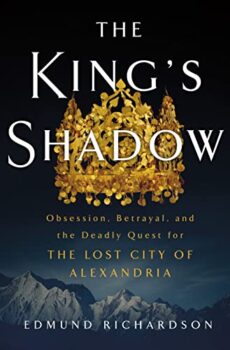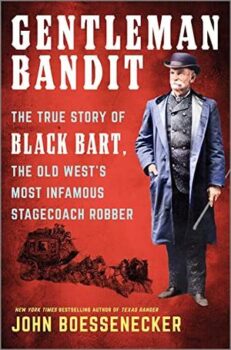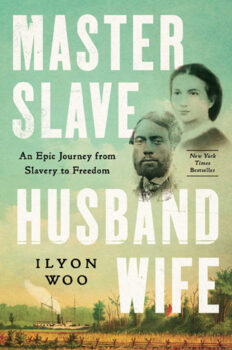Stranger Than Fiction
August 2023
Great Escapes
by Dean Jobb
It’s the season for getaways. What better time to check out recent nonfiction accounts of daring escapes from enslavement, prisons, the law, and the past.
In the late 1820s a London-born soldier serving in the private army of the British East India Company began an epic journey into Afghanistan. He called himself Charles Masson and, as a deserter, he faced a hangman’s noose if captured. As a ferenghi (a foreigner) with little knowledge of local languages, he faced plenty of other perils: the scorching heat and nighttime cold of arid deserts, clashes between feuding chieftains, spies on the hunt for deserters, thieves and murderers who preyed on travelers.
 British author and academic Edmund Richardson has meticulously reconstructed Masson’s improbable journey in The King’s Shadow: Obsession, Betrayal, and the Deadly Quest for the Lost City of Alexandria (St. Martin’s Press). It was a daunting task for the author, made more difficult by the fact Masson repeatedly lied about his past—his real name was James Lewis—and reinvented himself. “Tracing Masson’s footsteps,” Richardson concedes, “is like following a maze which changes shape as you explore it.” He was a charlatan in a time and place filled with frauds and shapeshifters. In Afghanistan he became an amateur archeologist on a mission to uncover the past as he escaped his own.
British author and academic Edmund Richardson has meticulously reconstructed Masson’s improbable journey in The King’s Shadow: Obsession, Betrayal, and the Deadly Quest for the Lost City of Alexandria (St. Martin’s Press). It was a daunting task for the author, made more difficult by the fact Masson repeatedly lied about his past—his real name was James Lewis—and reinvented himself. “Tracing Masson’s footsteps,” Richardson concedes, “is like following a maze which changes shape as you explore it.” He was a charlatan in a time and place filled with frauds and shapeshifters. In Afghanistan he became an amateur archeologist on a mission to uncover the past as he escaped his own.
Masson was determined to find one of the many cities Alexander the Great founded in the fourth century BCE as his armies swept into Asia. The list of lost metropolises includes one, somewhere in present-day Pakistan, named for Alexander’s horse, Bucephalus, who was killed in battle (confirming the great Greek conqueror’s penchant for founding new cities on a whim). Masson claimed to have found Alexandria Bucephalia—this turned out to be one of his many lies—but his real obsession was finding another city. Somewhere in Afghanistan was the site of Alexandria Beneath the Mountains, established in the shadow of the Hindu Kush range that bisects the country.
Richardson offers the intrigue, exotic locales, and mystery needed to keep readers engaged as he dissects Masson’s tall tales and narrates his subject’s unlikely quest to discover the secrets of the ancient world. Coins bearing inscriptions in Greek, found near the site of the present-day Bagram airbase, convinced Masson he was on the right track—or at least, gave him the ammunition he needed to convince backers to fund his search. What treasures will Masson unearth? Will he find the lost city? Or will his lies and his past catch up with him? To find out, escape into this breezy, entertaining, and enlightening book.
 In 1875, on an isolated stretch of road southeast of Sacramento, a man armed with a shotgun held up a Wells Fargo stagecoach. The flour sack covering his head, with slits cut for eyeholes, made him look more like a cartoon ghost than a real-life robber. He used an axe to break open the wooden express box, stripped it of cash and gold, grabbed any mail that contained money, and made a clean getaway. The brazen highwayman called himself Black Bart and would become, his biographer John Boessenecker notes, “the most notorious—and prolific—stage robber in American history.” Over the next eight years he stopped and looted more than two dozen stagecoaches across northern California.
In 1875, on an isolated stretch of road southeast of Sacramento, a man armed with a shotgun held up a Wells Fargo stagecoach. The flour sack covering his head, with slits cut for eyeholes, made him look more like a cartoon ghost than a real-life robber. He used an axe to break open the wooden express box, stripped it of cash and gold, grabbed any mail that contained money, and made a clean getaway. The brazen highwayman called himself Black Bart and would become, his biographer John Boessenecker notes, “the most notorious—and prolific—stage robber in American history.” Over the next eight years he stopped and looted more than two dozen stagecoaches across northern California.
Boessenecker, a prolific chronicler of law and disorder in the Old West, tells the story of this frontier rogue in Gentleman Bandit: The True Story of Black Bart, the Old West’s Most Infamous Stagecoach Robber (Hanover Square Press). His real name was Charles Boles and he was still an infant when his family emigrated from England to America in 1830. He joined the exodus to California during the gold rush of 1849 and fought for the Union in the Civil War (he was wounded twice). After the war he returned to prospecting for gold, with little success, before realizing the best place to find it was on a stagecoach. “I have had a rough life of it,” he later explained of his decision to steal what he found it difficult to find or earn.
His wartime service made him adept at living off the land and gave him the stamina to walk great distances (he fled his robberies on foot, never on horseback). He usually wore a bowler hat atop his flour-sack mask, never robbed passengers, and never fired his gun. He lifted the name Black Bart from a stage-robbing character in a popular adventure story of the time and left poems at the scene of a couple of his early heists, cementing his place in Western folklore. One bit of doggerel complained of how long he had labored “for honor, and for riches,” and taunted Wells Fargo and its employees as “fine haired sons of bitches.”
Between robberies, Boles retreated to San Francisco, passed himself off as Charles Bolton, a wealthy mine owner, and lived well off his loot. “He was a man of prepossessing manners, fluent and extremely entertaining in conversation,” one of his city friends recalled. His social circle included a few San Francisco detectives and the city’s fire chief.
Every legendary frontier outlaw deserves to have a clever, tenacious lawman on his trail, and Black Bart’s nemesis was Wells Fargo detective James Hume. Hume tracked him for years and, despite alerts to local sheriffs and detectives and an accurate description of the gentleman bandit, Boles evaded the possies organized to hunt him down. The tale of this flamboyant, larger-than-life crook is a perfect summer read for fans of true crime in the Wild West.
 A few days before Christmas, 1848 in Macon, Georgia, Ellen and William Craft launched a bold and ingenious escape from a prison that had held them captive for their entire lives: enslavement. The couple’s destination was Pennsylvania, a thousand miles to the north, but they would not take the Underground Railroad to freedom. They traveled openly by train, stagecoach, and steamer, risking detection and arrest at any moment. For five days, fellow passengers, railroad conductors, and steamship stewards did not see a husband and wife. Ellen, who was light-skinned and could pass as White, was dressed as a man and posed as William’s owner, a Southern gentleman named Johnson.
A few days before Christmas, 1848 in Macon, Georgia, Ellen and William Craft launched a bold and ingenious escape from a prison that had held them captive for their entire lives: enslavement. The couple’s destination was Pennsylvania, a thousand miles to the north, but they would not take the Underground Railroad to freedom. They traveled openly by train, stagecoach, and steamer, risking detection and arrest at any moment. For five days, fellow passengers, railroad conductors, and steamship stewards did not see a husband and wife. Ellen, who was light-skinned and could pass as White, was dressed as a man and posed as William’s owner, a Southern gentleman named Johnson.
Ilyon Woo recreates the Crafts’ remarkable story in Master Slave Husband Wife: An Epic Journey from Slavery to Freedom (Simon & Schuster). It’s a harrowing, moment-by-moment account of their hazardous journey that immerses readers in the brutal, claustrophobic world that enslaved persons endured in the Deep South on the eve of the Civil War. Woo made no attempt to embellish the tale, and there was no need to—the couple’s own account of their escape, published in 1860, and her impressive research into their times allows the author to record in immersive detail their hopes, thoughts, and fears and the obstacles and perils they faced.
One of their greatest challenges was navigating the inevitable request that “Mr. Johnson” sign his name to a travel document or hotel register. Ellen was illiterate—the enslaved were forbidden, by law, from being educated. To evade nosy officials and encourage other travelers to keep their distance, the couple devised an elaborate ruse. Ellen, her face obscured by bandages and thick glasses, pretended to be ill and claimed to be headed north to consult a physician, accompanied by William, her attentive “slave.” The ploy worked so well that Ellen encountered people who warned that her “boy” was liable to bolt once they reached Pennsylvania, while others urged William to take advantage of his master’s weakened condition and flee.
The Crafts’ daring journey energized the abolitionist cause and they were soon making public appearances to describe their escape. Their public profile, however, subjected them to new risks—under the draconian Fugitive Slave Law, they could be abducted and returned to their owners in Georgia to face brutal punishment for their defiance. And, as Woo’s meticulous research reveals, the couple could not escape racial prejudice. As they traveled through northern states and into Canada, jurisdictions where enslavement had been abolished, they continued to face hostility and discrimination. Their story is a disturbing and infuriating journey into a nightmarish world brimming with hatred and evil. Ultimately, however, it is an inspiring tale of hope, survival, and triumph.
 “An unspeakably grisly place.” That’s how Captain Pat Reid, a British officer captured after the fall of France in the spring of 1940, described Colditz, the clifftop castle near Leipzig in eastern Germany that housed the most troublesome and incorrigible Allied officers captured during World War Two. “Beautiful, serene, majestic and yet forbidding,” he added, “a sight to make the bravest quail.” The towering stone bastion looked escape-proof. For the men locked inside, getting out became a challenge and an obsession.
“An unspeakably grisly place.” That’s how Captain Pat Reid, a British officer captured after the fall of France in the spring of 1940, described Colditz, the clifftop castle near Leipzig in eastern Germany that housed the most troublesome and incorrigible Allied officers captured during World War Two. “Beautiful, serene, majestic and yet forbidding,” he added, “a sight to make the bravest quail.” The towering stone bastion looked escape-proof. For the men locked inside, getting out became a challenge and an obsession.
Ben Macintyre, the bestselling author of a wide shelf of books on espionage and wartime secret operations, tackles the story of the most infamous German prisoner-of-war camp in Prisoners of the Castle: An Epic Story of Survival and Escape From Colditz, the Nazis’ Fortress Prison (Crown). Think the 1960s television sitcom Hogan’s Heroes was fiction? Macintyre’s book is filled with real-life echoes of the program’s outrageous prisoner hijinks, brazen escape attempts, smuggled contraband, and guards scrambling to find hidden radios, caches of tools, and elaborate tunnels dug in bids for freedom. When one prisoner was caught trying to escape while dressed in a handmade German uniform, his captors joked—in a scene that could have been lifted from the show—that the poorly clad, ersatz soldier should be shipped to the Russian front.
The scale and audacity of the escapes and attempted escapes are jaw-dropping. French captives spent months digging a long tunnel they nicknamed “Le Métro” and stowed the excavated earth and stone in a castle attic that almost collapsed under the weight. While most escapees were caught before they could cross into neutral Switzerland, hundreds of miles away, enough scored a “home run” (as a successful escape became known) to encourage others to try their luck. The German army ran the prison and, unlike the fanatical SS and Gestapo, the staff honored the Geneva Convention and treated the officers surprisingly well. Captured officers were entitled to have orderlies—imprisoned enlisted men—to act as their valets, cooks, and servants. And when guards found a note left by one escapee, asking that his belongings be sent to his home, the Germans complied with the request. As Germany’s defeat loomed, however, fugitive prisoners faced summary execution if caught and Colditz’s inhabitants lived in fear of Nazi retribution.
Macintyre’s deep research makes this the definitive account of the battles of wits fought between captives and captors. His storytelling élan, coupled with his eye for drama and colorful characters, make this an impossible-to-put-down account as well. Along the way the author explodes myths about Colditz and explores how the national rivalries and class distinctions of the outside world were replicated within the community that formed behind the prison walls. If you’re looking to escape into a book about escapes, this one’s a home run.
————-
Award-winning true crime author Dean Jobb’s next book, A Gentleman and a Thief: The Daring Jewel Heists of a Jazz Age Rogue (Algonquin Books), will be released in June 2024. It’s the incredible story of Arthur Barry, who hobnobbed with the elite of 1920s New York while planning some of the most brazen jewel thefts in history. For more on this and Dean’s other books, find him at www.deanjobb.com.
Copyright © 2023 Dean Jobb
